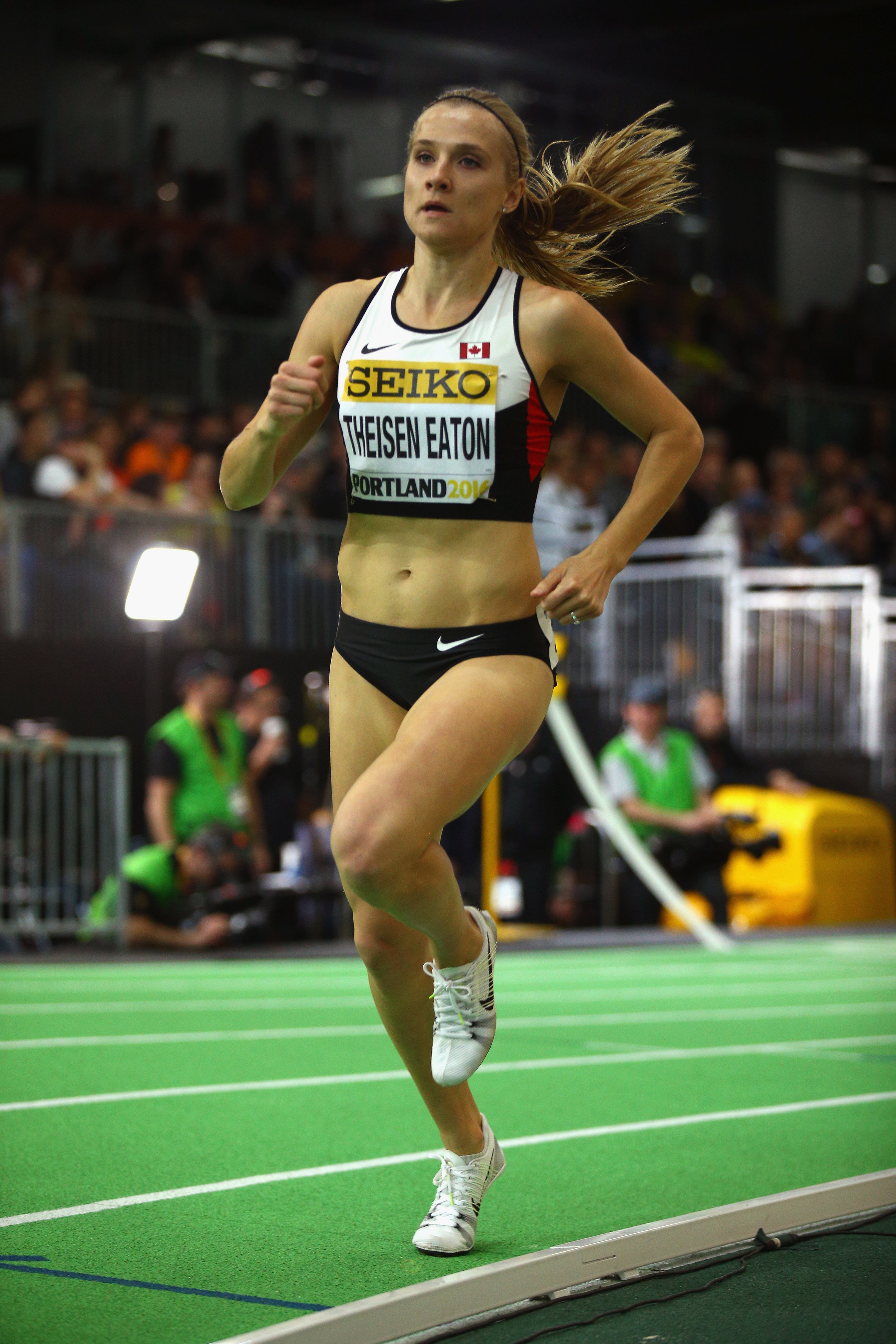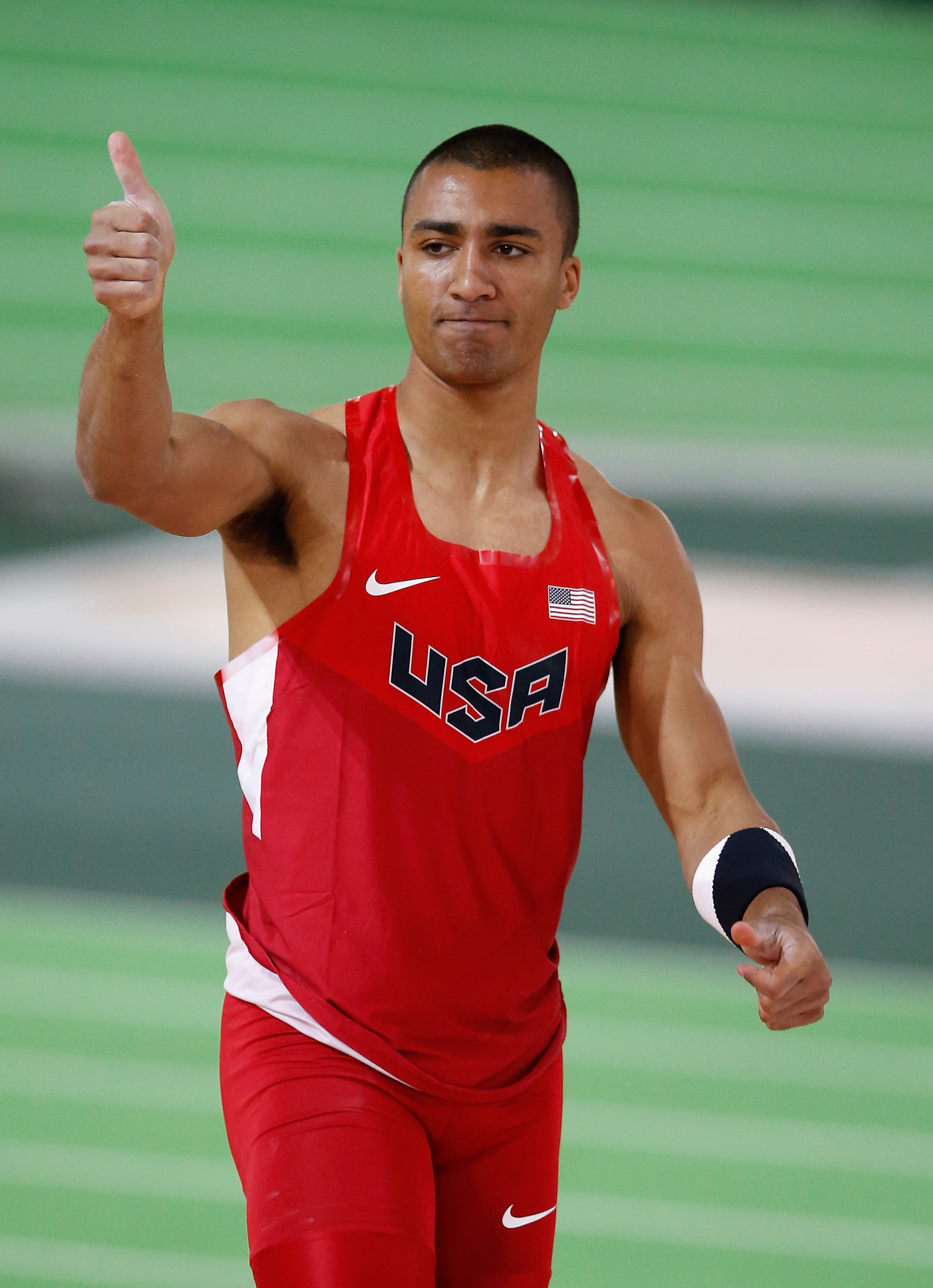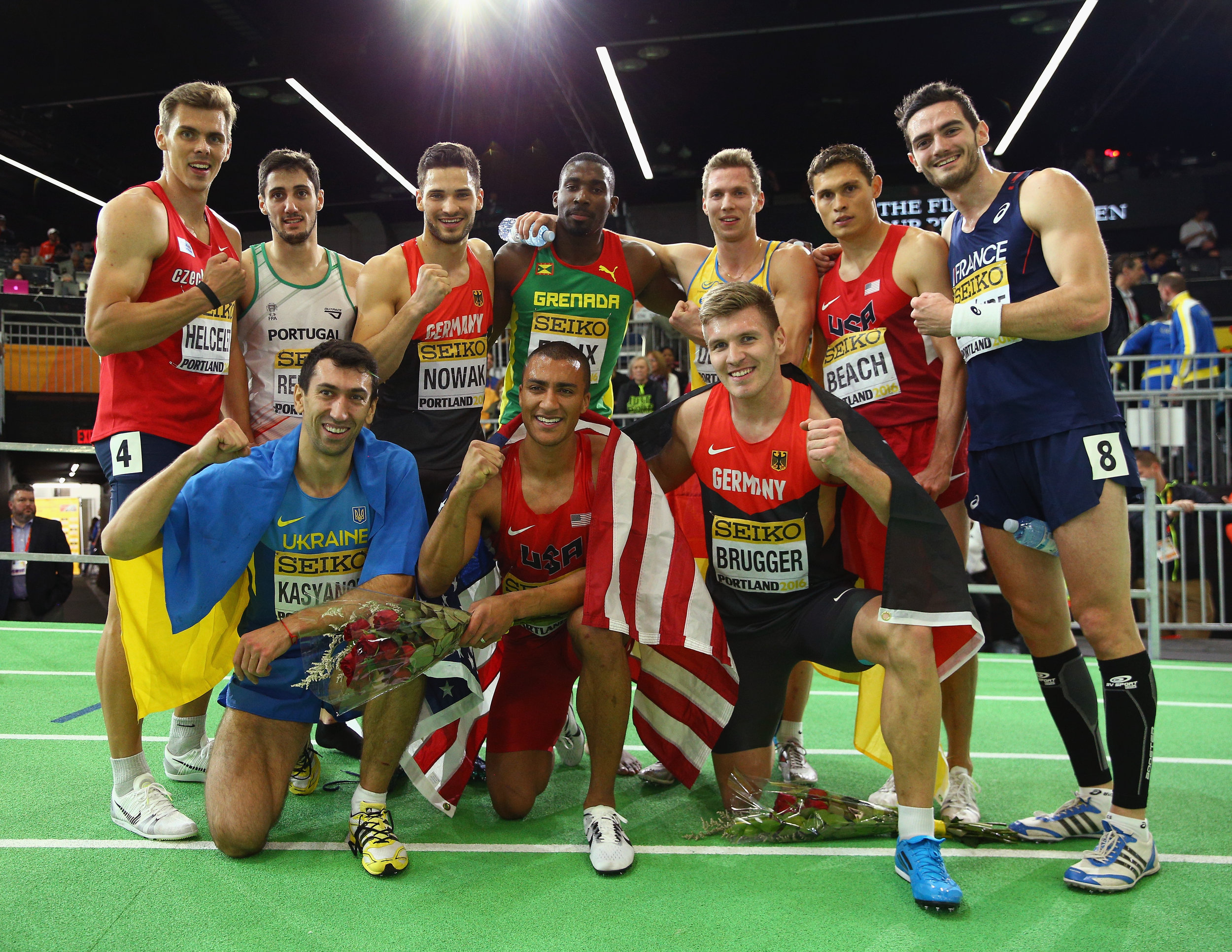PORTLAND, Ore. — Ashton Eaton and Brianne Theisen-Eaton are the best thing going in track and field. He won the heptathlon Saturday at the 2016 world indoor championships. She won the pentathlon the day before, her first world title. It’s not just that they win. It’s how they win. With grace. Dignity. Sportsmanship. Respect for themselves, their fellow athletes and the sport.
And with love.
There’s not a lot of visible love in track. With the Eatons, it’s different.
In the instant after Brianne was named the pentathlon winner, Ashton, in his warm-ups amid the long jump competition, bolted onto the track to embrace his wife.
That hug said not only that he knew what she had been through — because he was himself going through it — but how proud he was of her.
In a sport that has generated headlines for years, and intensely in recent months for all the wrong reasons, there is absolutely no question that Ashton and Brianne are emblematic of doing it the right way.
Don't doubt: Ashton and Brianne compete clean. There’s zero reason to entertain even a whisper of a suspicion. Never has been, never will be.
Enjoy this, people.
Better — cherish it.
Because even as Team Eaton stands atop the world, you can see that these 2016 indoors, in their way, may very well signal the beginning of the end.
Assuming Ashton re-qualifies this summer at the U.S. Trials in Eugene, which absent injury would seem a mortal lock, and then goes on to defend his London 2012 decathlon gold medal, the logical question awaits: what’s left to do? If, as seems likely, Brianne wins a medal in Rio, potentially gold, what's left to achieve?
Answer: nothing, really.
And these multi-event competitions are hard, really hard, on the body. He turned 28 in January. She turns 28 in December.
Brianne, who grew up in Saskatchewan and competes internationally for Canada, has lived in Eugene since 2007. She and Ashton went to school there, at the University of Oregon. Coming into this meet, she had won three world silver medals, two outdoor and one indoor.
She won that first international gold Friday night after leaping from third place to first in the final event, the 800, running an indoor personal-best 2:09.99.
Afterward, she said, “Whether it was a gold, silver or bronze, or no medal at all, I would have been satisfied with how I did.”
Asked about having Ashton nearby during competition, she said, “Seeing him calms me down. When you are in a stressful situation, competing at something like this, sometimes you want to give up or [you think], ‘I just can’t handle this pressure anymore.’ But seeing him on the sideline running toward me to help me with something helps calm me down a little bit and being able to celebrate this with him is really awesome and the cherry on the top.”
Ashton is the only combined events athlete in history to have won multiple world titles indoors and out, and to have secured multiple world records indoors and out. And of course that London 2012 gold.
“People call me the greatest athlete in the world and I don't feel like it,” Ashton said here earlier this week at a welcome dinner attended by both local dignitaries as well as staff and officials from the International Assn. of Athletics Federations, track’s worldwide governing body, including president Seb Coe.
“I just feel like the most fortunate person in the world.”
On Saturday afternoon, at the wrap-up of the pole vault part of the seven-event heptathlon, Ashton had the presence of mind to offer a shout-out to the thousands who had stayed at the Oregon Convention Center to watch him and the other athletes slogging through the heptathlon:
“Hey, I just want to say thanks to everybody for hanging out with us,” adding a moment later, “It really means a lot for you guys to stick around."
Last week, at the U.S. indoors, a stray pole vault bar cracked him on the top of the head, opening up a nasty cut that needed needed six stitches. No problem. He carried on, even making fun of it later on Twitter, calling it a “cutscene from a video game” and referring to himself as “#eatonstein.”
https://twitter.com/usatf/status/708759424588849152
https://twitter.com/AshtonJEaton/status/708773390304149504
In the 1000 meters on Saturday night, the event that wrapped up the heptathlon, Ashton knew going in he was in no position to set a world record. So instead of having American teammate Curtis Beach pace him for a potential record, it made way more sense for Ashton to push Beach — sixth overall heading into the run — in a bid to get Beach up to third.
Beach ran the 1000 in 2:29.04, a new indoor championships best, Eaton crossing third in 2:35.22.
"I feel like I was going a lot faster than what that clock said, I’ll tell you what," Eaton said after.
Beach ended up finishing fourth, just eight points away from a bronze medal. Mathias Brugger of Germany, who finished second in the 1000 at 2:34.10, ended up third overall, with 6126 points. Oleksiy Kasyanov of Ukraine took second, with 6182.
"I’d rather get fourth with that effort instead of third with a mediocre effort," Beach said. "This crowd was amazing. It was such a fun experience."
In winning the 2016 heptathlon, Ashton became the first three-time world indoor champion. His final score: 6470. No, not a world record. At the same time, Eaton now owns five of the top six heptathlon totals in history.
Asked if his victory measured up to his wife's, Ashton said, still standing on the track, "Honestly, no. I was thinking, you know what, it doesn’t matter what happens to me." Referring to Brianne's triumph, he said, "That made the whole meet for me."
And the entire crowd went, "Aww."
Heading into Rio, Ashton figures to be a big part of the NBC strategy for the Games, along with fellow track star Allyson Felix, swim king Michael Phelps and the gymnast Simone Biles.
The Olympic decathlon (men) and heptathlon (women) hold all the elements for outstanding a two-day reality-TV miniseries. The struggle, whether over 10 or seven events -- it's real.
After Rio, the stage would seem set for Ashton and Brianne to segue to whatever is the next chapter.
Broadcasting. Business. Foundation work. Parenthood.
Whatever.
A few days ago, the Eatons launched a concept called “What’s your gold?” The idea: to “share your journey toward a ‘personal gold’ — running a marathon, starting a business, fostering a shelter animal — whatever that ambition may be.”
After Rio, he — and she — have earned whatever they want to do.
"They help each other tremendously," their coach of six-plus years, Harry Marra, said. "They're a constant reinforcement to each other, and a support system," adding, "It's good to see."
Anyone with even a passing interest in track and field, however, ought to hope that each of them — and, as well, Marra, who is also a world-class person as well as coach — stays involved with the sport.
As things turn out, they may need track and field.
But the sport needs them more.
As their agent, Paul Doyle, told the IAAF website in a feature posted Thursday, “People often tell me that they think Ashton is the greatest athlete in the world. And I say, ‘No, he is the greatest human in the world.’ ”
At that Wednesday evening welcome dinner, Ashton told a story he had never before told in public.
When he was just 7 or 8, in a “small, mostly dirt-filled” little town in central Oregon called La Pine, about a half-hour south of Bend, Ashton started long-jumping.
Well, not formally. He was just doing what kids do — playing around.
But that play is so fundamental, so essential, to track and field — which, after all, is the foundation of every sport.
Ashton said he would go outside in the yard and find two sticks. He put the first on the ground. That would be his take-off mark. The second he would put out some little distance away, to see if he could jump that far.
When he jumped past that second stick, he said, he would re-set. His new landing spot was where he fixed the second stick. When he passed that new spot, he would re-set again.
And again.
He does something of the same thing now in practice, Marra said. Now it's with ropes -- the second rope set at, say, 25 feet. If he beats that, Ashton says, move it out to 25-6.
In high school, Ashton said, he went for the first time to the Prefontaine Classic at Hayward Field in Eugene, typically a late May stop each year on what is now called the IAAF’s Diamond League circuit.
Crediting his coach at Mountain View High in Bend, Tate Metcalf, for knowing “how to inspire a young athlete,” Ashton said, “He took me to Hayward Field to watch the Prefontaine Classic. I would not be standing here today had I not been sitting in the front row of the grandstands at the Prefontaine Classic that day.
“While I loved running and doing the long jump, I didn't know what track and field could be. But when I went to the Prefontaine Classic, I saw these athletes who were absolute gods and goddesses to me. Not only that, I saw the love and admiration that I just had to give these athletes, that the fans in Oregon were giving to these athletes. I thought, 'I want to be a part of that.'
“Without that event, without seeing the potential of track and field, I don't think I'd be here.
“What you guys do – constantly working, day in and day out – to put something like that competition on, I just can't thank you enough.
“Somewhere in a room like this, people are doing that,” he said. “And little do they know there's this kid jumping around in the dirt whose life will one day be changed because he saw a track meet that these people put on, and the athletes that they were able to host displayed their skills so that this young athlete could be inspired. I honestly can't thank you guys enough.”









